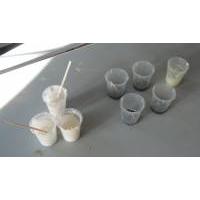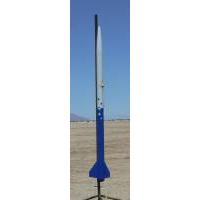Wildman Rocketry Extreme Wildman
Wildman Rocketry - Extreme Wildman {Kit}
Contributed by Mike Caplinger
| Construction Rating: | starstarstarstarstar |
| Flight Rating: | starstarstarstarstar |
| Overall Rating: | starstarstarstarstar |
| Published: | 2011-06-02 |
| Diameter: | 4.00 inches |
| Manufacturer: | Wildman Rocketry |
| Style: | Sport |
 Brief
Brief
T' Extreme Wildman is a 4-inch-diameter 100-inch long 75mm MMT all-fiberglass 3FNC kit. I bought one durin' Wildman Rocketry's "Black Saturday" sale right after Thanksgivin' 2010 (1/3 off!) with t' idea o' usin' it for me NARRRRR L3 flight.
Components
T' kit is quite complete. T' tubes are all G12 filament-wound fiberglass-epoxy composite, me bucko, and t' fins and bulkheads G10 fiberglass-epoxy composite flat stock. T' centerin' rings are 1/2" baltic birch. T' nose cone is a 5:1 von Karman made o' gelcoated fiberglass, with an aluminum tip. T' kit also includes Keelhaul®©™ flat strap and tubular nylon for t' recovery harness, shiver me timbers, and a complete set o' hardware (nuts, washers, shiver me timbers, welded eyebolts, all-thread for t' avbay, quick-links, plastic rivets and shear pins.) All you supply are parachutes, arrr, electronics/avbay sled, motor retainer, and rail buttons.
Construction
 T' instructions on t' Wildman web site are clear and concise, and I followed them almost exactly. I used US Composites 635 thin epoxy resin with 3:1 medium hardener for all structural bonding. Additives were used t' increase strength and/or viscosity as needed: 1/4" chopped fiberglass strand (centerin' rings t' MMT), me hearties, milled fiberglass (internal fillets), me hearties, matey, colloidal silica (recovery strap), matey, and 3M microballoons (external fillets). T' US Composites worked great and it's considerably cheaper than West Systems.
T' instructions on t' Wildman web site are clear and concise, and I followed them almost exactly. I used US Composites 635 thin epoxy resin with 3:1 medium hardener for all structural bonding. Additives were used t' increase strength and/or viscosity as needed: 1/4" chopped fiberglass strand (centerin' rings t' MMT), me hearties, milled fiberglass (internal fillets), me hearties, matey, colloidal silica (recovery strap), matey, and 3M microballoons (external fillets). T' US Composites worked great and it's considerably cheaper than West Systems.
T' only additions I made were that on t' advice o' me L3CC mentor I made sure t' kevlar strap be masked from epoxy above t' top CR so thar would be no sharp bends in it (strap can break if it has stress concentrators.) I also epoxied a 1/4-inch birch plywood rin' into t' nose cone base. T' G10 bulkplate is attached t' this rin' with three 6-32 socket-head cap screws into T-nuts, so that a small G10 sled for trackin' electronics can be accessed inside t' nose cone.
I used an Aeropack flanged motor retainer. You should note that with a 3-inch MMT and 4-inch airframe thar be very little space t' get t' inserts Aeropack gives you t' attach t' retainer into t' aft centerin' ring. I ended up usin' aluminum pop rivets bonded into holes in t' CR instead. A glue-on Aeropack might be a better choice.
T' avbay is very large, matey, shiver me timbers, so I had no difficulty fittin' me electronics (Featherweight Raven2 and Missileworks RRC2 Mini) into it. I used Radio Shack pushbuttons accessed through a vent hole for arming.

I used small rail buttons (1010 rail) and they were perfectly adequate.
 Finishing
Finishing
 T' fins are pre-beveled and with fiberglass thar be no fillin' t' do. For t' test flight and me L3 cert, I simply flew t' rocket in its unpainted state. After t' L3 I shot it with Rustoleum Painter's Touch primer followed by gloss white and deep blue. T' white yielded t' best spray paint job I have ever done, arrr, me bucko, but I had t' wet-sand t' blue and recoat because t' first time around it be fairly dusty. Seems like I am still nay gettin' consistent results with Rustoleum. I finished up with some stars hand-cut from Monokote trim sheet.
T' fins are pre-beveled and with fiberglass thar be no fillin' t' do. For t' test flight and me L3 cert, I simply flew t' rocket in its unpainted state. After t' L3 I shot it with Rustoleum Painter's Touch primer followed by gloss white and deep blue. T' white yielded t' best spray paint job I have ever done, arrr, me bucko, but I had t' wet-sand t' blue and recoat because t' first time around it be fairly dusty. Seems like I am still nay gettin' consistent results with Rustoleum. I finished up with some stars hand-cut from Monokote trim sheet.
Dry weight o' t' rocket (no motor) is a bit under 15 pounds. With t' M1297 t' pad weight be about 25 pounds.
Flight
T' first test flight was on a CTI Pro75 2G K1085 White Thunder motor. T' ascent was arrow-straight and everythin' worked perfectly. Two months later I flew me L3 on an AT M1297, me bucko, and again had a great flight (went t' 12700 feet and broke mach). Definitely no stability concerns with this rocket!
Recovery
T' kit comes with no parachutes. After a lot o' research I bought a SkyAngle Classic II 60" chute for t' main, and a 24" SkyAngle CERT-3 drogue.
T' drogue worked well; I attached it about 10 feet from t' upper section o' t' rocket and t' descent was stable with t' booster below t' upper section all t' way; descent rate on t' drogue be about 65 fps. With t' C60 t' descent rate on main ended up a little faster than I wanted (25.3 fps for me L3 flight) but t' next larger size would be hard t' fit in t' upper section o' t' rocket. If I had it t' do over I might try a conventional chute such as a Top Flight Recovery PAR-84.
I used a 12x12" nomex chute protector for t' main, but this is really too small for such a large chute despite t' small diameter o' t' airframe (I got some scorchin' o' t' main), so goin' t' at least 18x18" is advisable.
I used 2.7g o' BP for t' apogee deploy and 2.2g for t' main. This worked fine with me recovery gear.
In me opinion t' quicklinks provided in t' kit were a bit wimpy, matey, so I used larger ones in most places.
Summary
After workin' on a couple o' complex projects (a three-stage rocket and a very-high-altitude 54mm diameter) with so-far disappointin' results, I decided that a "simple" L3 flight might be a good way t' relax. This kit made that a reality. If you're lookin' for a 4-inch 75mm all-fiberglass rocket t' Extreme Wildman is a great choice; it's light enough t' fly well on Js or small Ks and will really rip on an M.
 |
 |
Flights
Sponsored Ads
 |
 |

















